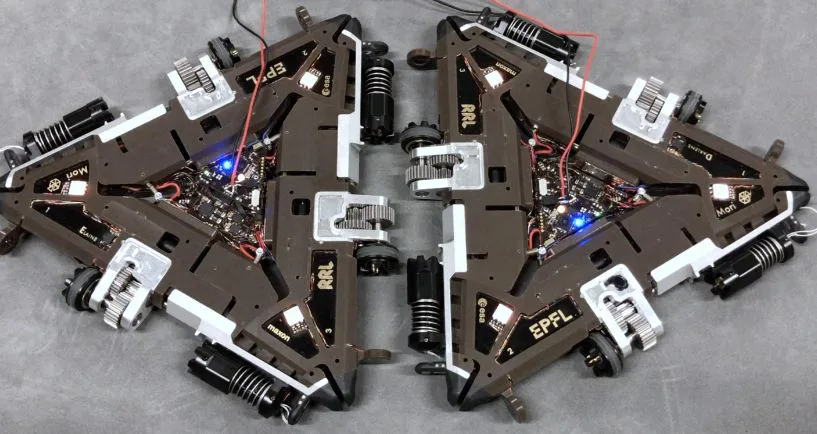
Researchers at EPFL have tried to integrate two worlds to create a remarkable breakthrough. Combining digital polygon meshing with biological swarm behavior, they have developed the Mori3 robot.
The technology has the potential to revolutionize modular robotics and shape-shifting capabilities.
Mori3 effortlessly transitions from 2D triangles into virtually any 3D object. It, surely, is an important step forward in the realm of robotics and its applications, particularly in space exploration. Let’s delve directly into this exciting development and its implications for the future.
Origami-inspired robot
The reconfigurable robot is inspired from origami. Very effortlessly, Mori3, can assemble and disassemble as per the environmental demands and tasks at hand.
This transformative robot possesses the ability to adapt its size, shape, and function. Thus, it opens up endless possibilities for various applications and industries.
Mori3’s shape-shifting prowess
One of the most remarkable capabilities of Mori3 is its ability to seamlessly transform from 2D triangles into complex 3D structures.
This shape-shifting prowess draws inspiration from the intricate world of polygon meshing and the adaptability observed in biological swarm behavior.
By combining these two concepts, the Mori3 robot can morph and reshape itself to meet the specific needs of any given scenario.

Implications for space travel
Of course, the technology behind the shape-shifting robot gives it limitless options to explore. However, there is one area where it can outsmart the conventional tech and that is, space travel.
As humanity is looking forward to venture into space, the possibility of versatile and adaptable robots will give them an upper edge.
This reminds me of TARS from the movie “Interstellar”. Although was not a shape-shifting robot. But it had a rectangular, monolithic appearance with multiple independently moving limbs.
Its design focused more on mobility and adaptability within its existing form, rather than true shape-shifting abilities.
While, Mori3’s versatility holds significant value for space exploration missions as it can assist in the following areas:
Assemble structures: By leveraging its shape-shifting capabilities and the interconnectedness of its components, Mori3 can reconfigure itself to fit the requirements of the assembly process.
Conduct repairs: The flexibility of Mori3 allows it to change its shape and size to access tight spaces or reach specific areas that require repair.
Its modular units can be configured and rearranged to accommodate the specific repair needs, whether it involves replacing components, adjusting mechanisms, or performing intricate repairs on complex systems.
Adapt to various terrains: Mori3 can modify its shape and size to overcome obstacles, uneven surfaces, or challenging terrains.
By reconfiguring its modular units, it can adjust its locomotion strategy to suit the specific terrain it encounters. This adaptability enables the bot to move smoothly and efficiently across diverse landscapes, such as rough terrain, uneven surfaces, or even confined spaces.

Applications in diverse industries
The applications of Mori3 can be extended to far beyond the field of space industry. The adaptable robot has the potential to revolutionize other industries as well. For instance, it could be used in:
Construction: Construction sites often present diverse terrains and conditions. Mori3’s ability to adapt to various terrains allows it to navigate rough or uneven surfaces. Thus, it could assist in site preparation, earthmoving, or construction activities in challenging environments.
Infrastructure development: The bot can be employed to assess and inspect existing infrastructure, such as bridges, tunnels, or buildings.
Its ability to adapt its shape and size allows it to access hard-to-reach areas and collect data for condition assessment, structural integrity analysis, and maintenance planning.
Disaster response: Mori3 can be utilized to transport essential supplies, medical equipment, or tools to areas where traditional access may be challenging.
Its adaptability allows it to navigate through rough terrain or debris. Thus, ensuring the timely delivery of critical resources to affected communities.
Search-and-rescue missions: The robots’ ability to adapt its shape and size allows it to access confined spaces.
It can assist in locating and rescuing individuals trapped in collapsed buildings, rubble, or other hazardous areas. Thus, improving the efficiency and effectiveness of search and rescue missions.
Remote monitoring and data collection: Equipped with sensors and cameras, Mori3 can be deployed to collect valuable data from disaster-affected areas.
It can gather information on environmental conditions, structural stability, or potential hazards, aiding in decision-making and prioritizing response efforts.
Mori3’s ability to morph its shape and function based on the task at hand has, indeed, opened up exciting avenues for efficiency, versatility, and problem-solving.

Takeaway
The fusion of digital inspiration and biological principles has paved the way for the shape-shifting robot. The Mori3 robot stands at the forefront of a new era in robotics.
No doubts, the tech will bring new levels of efficiency and effectiveness to countless applications.
Exciting times lie ahead as we witness the transformative potential of shape-shifting robots like Mori3 shaping our world.
Via: EPFL



